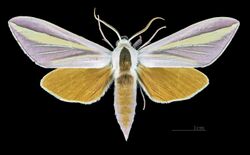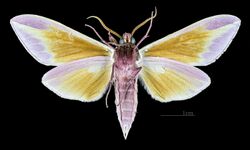Biology:Leucophlebia lineata
| Large candy-striped hawkmoth | |
|---|---|

| |
| Male dorsal | |

| |
| Male ventral | |
| Scientific classification | |
| Domain: | Eukaryota |
| Kingdom: | Animalia |
| Phylum: | Arthropoda |
| Class: | Insecta |
| Order: | Lepidoptera |
| Family: | Sphingidae |
| Genus: | Leucophlebia |
| Species: | L. lineata
|
| Binomial name | |
| Leucophlebia lineata Westwood, 1847[1]
| |
| Synonyms | |
| |
Leucophlebia lineata, the large candy-striped hawkmoth, is a moth of the family Sphingidae. It was described by John O. Westwood in 1847. It is known from Sri Lanka, India , Nepal, Thailand, eastern and southern China , Taiwan, Cambodia, Vietnam, Malaysia (Peninsular, Sarawak), Indonesia (Sumatra, Java, Kalimantan, Flores, Sulawesi) and the Philippines .[2] It is a minor pest of sugarcane.[3][4]
Description
The wingspan is 62–82 mm. The forewing upperside is similar to other Leucophlebia species in having broad pinkish costal and outer marginal areas and a paler median band, but differs in having the hind margin paler, nearer the colour of the median band, and with some picked out in white. The larvae feed on coarse grasses of the family Poaceae.
In The Fauna of British India, Including Ceylon and Burma: Moths Volume I, the species is described as follows:
Palpi and frons brown; antennae ochreous; vertex of head and sides of thorax and abdomen pale pink; a brownish ochreous stripe on vertex of thorax and abdomen. Fore wing bright pink; a yellow stripe from the base of cell to apex, widest beyond the cell; a short narrow yellow streak in the interno-median interspace from the base; veins 2,3 and 4 white, with some diffused fuscous below them. Hind wing tawny. Cilia yellowish white. The form rosea from South India and Ceylon, is rather smaller and darker than typical lineata. Larva green covered with tubercles; a broad white lateral stripe; head white, with a pink streak on gulae; horn and legs pink.[5]
References
- ↑ "CATE Creating a Taxonomic eScience - Sphingidae". Cate-sphingidae.org. Archived from the original on 2012-12-28. https://archive.today/20121228183647/https://www.cate-sphingidae.org/taxonomy/Leucophlebia/lineata.html. Retrieved 2011-11-01.
- ↑ "Leucophlebia lineata Westwood, 1848". http://indiabiodiversity.org/species/show/268492. Retrieved 5 July 2016.
- ↑ Pittaway, A. R.; Kitching, I. J. (2018). "Leucophlebia lineata Westwood, 1847 -- Large candy-striped hawkmoth". http://tpittaway.tripod.com/china/l_lin.htm. Retrieved December 15, 2018.
- ↑ "Leucophlebia lineata". http://www.insectlifeforms.com/605020557843834/Moths_-_Hawk_Or_Sphinx__Leucophlebia_lineata__9834.aspx. Retrieved 5 July 2016.
- ↑ Hampson, G. F. (1892). The Fauna of British India, Including Ceylon and Burma: Moths Volume I. Taylor and Francis. https://www.biodiversitylibrary.org/item/180068#page/5/mode/1up.
Wikidata ☰ Q2202651 entry
 |

